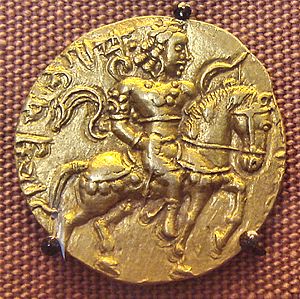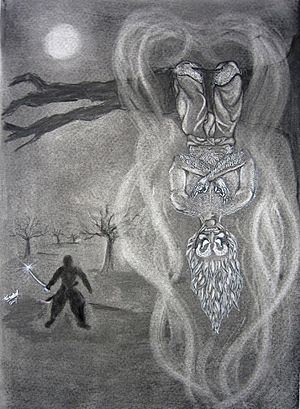Vikramaditya facts for kids
Quick facts for kids Vikramaditya |
|
|---|---|
| Chakravarti Samrat | |

A modern depiction of Vikramaditya in Ujjain
|
Vikramaditya was a famous king from ancient Indian stories. He is a legendary hero, meaning his tales are very popular but might not be entirely true history. You can find him in hundreds of traditional stories, like Baital Pachisi and Singhasan Battisi.
Many stories say he ruled from Ujjain, a city in India. Sometimes, other cities like Pataliputra or Pratishthana are mentioned as his capital. The name "Vikramaditya" was also a special title used by several Indian kings.
People often believe that Vikramaditya started the Vikram Samvat calendar era in 57 BCE. This was supposedly after he defeated a group of invaders called the Shakas. However, this calendar era was only called "Vikrama Samvat" much later, after the 9th century CE. It's thought that the legends about Vikramaditya might be a mix of stories about different real kings who used this title, especially Chandragupta II.
Contents
Who Was Vikramaditya?
Early Stories
Some experts think Vikramaditya was a real king from Ujjain. They believe he was a Malava king who defeated the Shakas around the 1st century BCE. This victory might have been the start of the Krita era, which later became known as the Vikram Samvat.
Later, a king named Chandragupta II also took the title Vikramaditya after defeating the Shakas. Some people argue that the stories about Vikramaditya existed even before Chandragupta II's time. They say he couldn't be based on Chandragupta II because the Gupta capital was in Pataliputra, not Ujjain.
However, other experts disagree. They point out that many of the old stories about Vikramaditya seem to have parts added later. Also, there's no clear proof like old coins or writings that show a powerful king named Vikramaditya ruled around the 1st century BCE.
Gupta Kings and Vikramaditya
Many kings from the Gupta Empire used titles similar to Vikramaditya. It's believed that the brave deeds of these kings became part of the Vikramaditya legends over time. People might have forgotten the differences between them.
Chandragupta II's Connection
Many scholars think that the legendary Vikramaditya is probably based on the Gupta king Chandragupta II. Coins and old writings show that Chandragupta II used the title Vikramaditya. His victory against the Shakas was a big deal, and some think this event was later linked to the fictional Vikramaditya.
Even though the Gupta capital was Pataliputra, Chandragupta II might have defeated the Shakas in Ujjain. He might have even made Ujjain a second capital. This could be why many legends say Vikramaditya ruled from Ujjain.
Skandagupta's Connection
Some scholars also connect the Vikramaditya of Ayodhya legends to Skandagupta, another Gupta king who ruled from 455 to 467 CE. Skandagupta's father, Kumaragupta I, used the title Mahendraditya. Since Skandagupta took the title Vikramaditya, some stories about him might have become part of the larger Vikramaditya legends.
Other Rulers
The Kathasaritsagara, a collection of stories, mentions Vikramaditya as the ruler of Pratishthana. The Satavahanas were a famous ancient family who ruled from Pratishthana. One of their kings, Gautamiputra Satakarni, defeated the Shakas. However, the Satavahanas never ruled from Ujjain or Pataliputra, which are often mentioned as Vikramaditya's capitals.
Some people thought the Vikramaditya legends were based on Yashodharman, a king from the 6th century. He used the Malava era in his writings, which later became known as Vikrama Samvat. But Yashodharman's capital was not Ujjain, and he defeated the Hunas, not the Shakas.
What Does His Name Mean?
The name Vikramaditya means "the sun of bravery." Vikrama means "bravery," and aditya means "sun." He is also known as Vikrama, Bikramjit, and Vikramarka. Arka also means "sun."
Some stories say he freed India from invaders called mlechchhas. These invaders are usually identified as the Shakas. Because of this, he is also known as Shakari, which means "enemy of the Shakas."
Early Stories of Vikramaditya
Some very old writings, from before the Gupta period (240–550 CE), mention Vikramaditya. However, parts of these writings, including the mentions of Vikramaditya, might have been added later during the Gupta era.
The earliest work that might have mentioned Vikramaditya was Brihatkatha. This was an Indian epic poem written a long time ago. We don't have the original book, but we know about it from other books written later. So, it's hard to be sure if the original Brihatkatha had the Vikramaditya stories we know today.
Another old collection of poems, Gaha Sattasai, mentions a king named Vikramaditya who was very generous. But some parts of this work also seem to have been added later during the Gupta period.
The first clear mentions of Vikramaditya appear in works from the 6th century. One story says Vikramaditya ruled from Ayodhya. He was known for his generosity and for supporting scholars. Another story, from a Chinese traveler named Xuanzang, also talks about Vikramaditya's great generosity and a debate between a Buddhist monk and other scholars.
Legends from 10th to 12th Centuries
Brihatkatha Adaptations
Later versions of the Brihatkatha, like Brihatkathamanjari and Kathasaritsagara, tell many exciting stories about Vikramaditya. These stories often include fantasy elements and show his great power.
One legend describes Vikramaditya's rivalry with the king of Pratishthana. In this version, Vikramaditya's capital is Pataliputra. He tries to conquer Pratishthana but fails. He then secretly enters the city and uses magical golden statues to gain fame. Eventually, he befriends the king of Pratishthana and marries a local woman.
Book 12 of Kathasaritsagara contains the famous Baital Pachisi stories, also known as the "25 Vetala Tales." In these stories, a king tries to catch a vetala (a ghostly being). The vetala tells him a puzzling story and asks a question. If the king answers correctly, the vetala escapes. If he doesn't, his head will explode! In some versions, the king is named Trivikramasena, but later stories clearly say he is Vikramaditya of Ujjain.
Another legend says that the gods asked Shiva to send someone to defeat evil forces. Shiva sent his attendant, Malyavat, to be born as Vikramaditya, the prince of Ujjain. Vikramaditya grew up to be a powerful warrior who conquered many kingdoms and defeated demons. His generals also helped him expand his empire across India.
Rajatarangini
The Rajatarangini, a historical book from the 12th century, mentions that Harsha Vikramaditya of Ujjayini defeated the Shakas. It also says that Vikramaditya made his friend, the poet Matrigupta, the ruler of Kashmir.
Other Legends
Some legends, especially Jain stories, describe a rivalry between Vikramaditya and another legendary king named Shalivahana of Pratishthana. In some tales, Shalivahana defeats Vikramaditya and starts his own calendar era. In others, Vikramaditya is an ancestor of Shalivahana.
One Jain story says that Vikramaditya's father, Gardabhilla, kidnapped the sister of a Jain teacher. The Shakas then invaded Ujjain and captured Gardabhilla. Later, Vikramaditya came from Pratishthana, defeated the Shakas, and started the Vikrama Samvat era to celebrate his victory.
Other Jain texts tell a different story where Shalivahana defeats Vikramaditya. Shalivahana, who was born with special powers, used magic to turn clay figures into a real army. He defeated Vikramaditya, who then fled. Shalivahana then started his own era.
Paramara Legends
The Paramara kings, who ruled in India from the 9th to the 14th century, linked themselves to Vikramaditya. They did this to make their own rule seem more important and powerful.
Simhasana Dvatrimsika
The Simhasana Dvatrimsika, also known as Singhasan Battisi, is a collection of 32 folktales about Vikramaditya. In these stories, a later king named Bhoja finds Vikramaditya's ancient throne. The throne has 32 statues, which are actually magical spirits called apsaras.
When Bhoja tries to sit on the throne, one apsara comes to life. She tells him he can only sit on the throne if he is as generous and good as Vikramaditya. She then tells a story about Vikramaditya's virtues. This happens 32 times, with each apsara telling a new tale. After each story, Bhoja admits he is not as great as Vikramaditya. Finally, the statues are pleased with his humility and let him sit on the throne.
Bhavishya Purana
The Bhavishya Purana, an ancient Hindu text, also connects Vikramaditya to the Paramara kings. It says that Vikramaditya was a descendant of the first Paramara king.
According to this text, Vikramaditya was sent to Earth by Shiva to fix the world. He had a special throne with 32 designs (like in Singhasan Battisi). Shiva's wife, Parvati, created a vetala to protect Vikramaditya and give him riddles (like in Baital Pachisi). After hearing the vetala's stories, Vikramaditya performed a special horse sacrifice to mark his vast empire. His empire stretched across India, from the Indus River in the west to Rameshwaram in the south.
Jain Legends
Many stories by Jain writers also feature Vikramaditya. These stories became more common after the 12th century. A main idea in Jain tradition is that a Jain teacher named Siddhasena Divakara convinced Vikramaditya to follow Jainism.
Jain stories also adopted the popular Singhasan Battisi and Vetala Panchavimshati tales. The Jain writer Hemachandra named Vikramaditya as one of four very wise kings.
Tamil Legends
In some old Tamil legends, Vikramaditya has 32 special marks on his body, which are signs of a great emperor. One story tells how he was willing to sacrifice himself to a goddess to get special mercury. But the goddess granted his wish without him needing to sacrifice himself.
Another Tamil legend says Vikramaditya offered to cut his body in nine places to please the gods. In return, he convinced the goddess to stop human sacrifices.
An old Tamil manuscript also tells a story where Shalivahana (also called Bhoja) defeats Vikramaditya. Shalivahana then starts to trouble people who worship Shiva and Vishnu. So, Shiva creates three Tamil kings to defeat Shalivahana.
Ayodhya Legend
A legend in Ayodhya says that the city was lost for many centuries and then found again by Vikramaditya. He was guided by a king of holy places and a yogi (a spiritual person). The yogi told him to follow a cow and calf, and Ayodhya would be where milk started to flow from the cow's udder. Following this advice, Vikramaditya found the ancient city.
Some historians think that the Gupta emperor Skandagupta, who was also known as Vikramaditya, moved his capital to a place called Saketa and renamed it Ayodhya. This might be why Vikramaditya is linked to Ayodhya.
Legacy and Popular Culture
Vikramaditya's stories are very popular even today. Many of his adventures appear in the Amar Chitra Katha comic-book series. There have also been many Indian films made about King Vikramaditya, including Vikramaditya (1945) and Bhatti Vikramarka (1960).
Television shows like Vikram Aur Betaal from the 1980s and its remake Kahaniya Vikram aur Betaal Ki are based on the Baital Pachisi stories. Adaptations of Singhasan Battisi have also been aired on TV.
The Indian Navy aircraft carrier INS Vikramaditya was named in his honor. In 2016, India Post released a special postage stamp to honor Samrat Vikramaditya.
Connection to Calendar Eras
After the 9th century, a calendar era that started in 57 BCE became known as the Vikram Samvat. Some legends also link the Shaka era (which began in 78 CE) to Vikramaditya.
When a Persian scholar named Al-Biruni visited India, he learned about different calendar eras. He heard a legend that a Shaka ruler invaded India and was defeated by King Vikramaditya in 78 CE. This event supposedly started a new era.
However, there's a big time difference between the 57 BCE era and the 78 CE era. This means that the Vikramaditya who started the 57 BCE era and the one who defeated the Shakas in 78 CE couldn't be the same person. The name of the 57 BCE era only changed to Vikrama Samvat much later. Many scholars believe this change happened during the time of Chandragupta II, who used the title "Vikramaditya."
See also
 In Spanish: Vikramāditya para niños
In Spanish: Vikramāditya para niños



